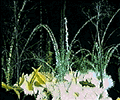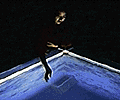Interaction 95 |
1999.09.01 |
Christa Sommerer studied botany at University of Vienna and art at Academy of Fine Arts Vienna. Laurent Mignonneau Art, Media and Video in Angouleme France. Since 1992 they collaborate and develop interactive computer installations, that are related to A-Life, Communication, Virtual Reality and Multi Media Art. Their permanent interactive computer installation “Trans Plant” is installed at the “Tokyo Metropolitan Museum of Photography” 1995, an other permanent exhibit will be installed at the AEC Ars Electronica Center in Linz, Austria. They received numerous awards in Interactive Art, Multimedia and Technology. Since 1995, they both hold a research position as Invited Researchers at ATR Media Integration & Communications Research Laboratories, Kyoto, Japan, searching in the field of Telecommunication, Artificial Life and Image Communication. Interactive Plant Growing  The interactive computer installation Plant Growing was developed and programmed by Laurent Mignonneau and Christa Sommerer at Institut für Neue Medien, Frankfurt, Germany. The interactive computer installation Plant Growing was developed and programmed by Laurent Mignonneau and Christa Sommerer at Institut für Neue Medien, Frankfurt, Germany.It deals with the sensitive relationship between 5 real plants and 5 or more human viewers, who can initiate and control by their hands a high developed 3-dimensional real-time growth of virtual plants. By producing a sensitive interaction with the real plants, the viewers too become a part of the installation. They decide how this interaction is translated to the screen and how the growth takes place on the screen. Plant structures on the screen are programmed as plant-algorithms; they can develop and grow in 3 dimensions, rotate, scale, translate, deform and vary. This means, ARTIFICIAL GROWING is performed in REAL TIME in the 3-DIMENSIONAL SPACE of the computer. In this way this produced pictures get projected on a video projection screen in front of the viewers. In the installation the electrical potential difference between viewers and plants is directly transformed into electrical signals which conduct how the virtual plants grow on the screen. The viewers thus perform a dialog with the real plants; they can see the interpretation of this dialog in real-time on the project screen. The viewers can stop, continue, deform, cross and rotate the plants, develop new forms and produce in this way always unexpected new combinations and variations of growth, which only depend on their interactive dialog with the real plants. The growing processes are programmed to be very flexible; they are not predetermined, so the result on the screen is always new and different, depending on the interaction VIEWER-PLANT. A-Volve  In the interactive real-time environment A-Volve visitors interact with virtual creatures in the space of a water filled glass pool. In the interactive real-time environment A-Volve visitors interact with virtual creatures in the space of a water filled glass pool.These virtual creatures are products of evolutionary rules and influenced by human creation and decision. Designing any kind of shape and profile with their finger on a touch screen, visitors will “bear” virtual three dimensional creatures, that are automatically “alive” and swim in the real water of the pool. The movement and behavior of the virtual creature is decided by its form, how the viewer was designing it on the touch screen. Behavior in space is, so to speak, an expression of form. Form is an expression of adaptation to the environment. Form and movement are closely connected, the creatures capability to move will decide its fitness in the pool. The fittest creature will survive longest and will be able to mate and reproduce. The creatures will compete by trying to get as much energy as possible. Thus predator creatures will hunt for prey creatures, trying to kill them. The creatures also interact with the visitors, by reacting to their hands movement in the water. If a visitor tries to catch a creature, it will try to flee or stays still, if it gets caught. Thus the visitor is able to influence the evolution by for example protection preys against predators. If two strong creatures meet, they can create an offspring and a new creature can be born. It carries the genetic code of its parents. Mutation and cross-over provide a nature-like reproduction mechanism, that follows the genetic rules of Mendel. This newly born offspring will now also react and live in the pool, interacting with visitors and other creatures. Algorithms, developed by Mignonneau and Sommerer ensure smooth and natural movement and “animal-like” behavior of the creatures. None of the creatures is pre calculated, they are all born exclusively in real time through the interaction of the visitors and the interaction of the creatures themselves. Thus an unlimited variety of forms will be possible, representing human and evolutionary rules. By closely connecting the real natural space of the water to the unreal virtual living space of the creatures, A-Volve minimizes the borders between “real” and “unreal”, creating a further step (after “Interactive Plant Growing”) in the search of “Natural Interfaces” and “Real-Time Interaction”. ‘A-Volve’ was supported by ICC Inter Communication Center, NTT, Japan and realized at ATR, Advanced Telecommunication Research Lab, Japan. A-Volve 1994, NTT-ICC, Japan Interactive Plant Growing 1994, Helsinki, Finland |
| Interaction 95 >> | |
E-Mail : info@iamas.ac.jp |

